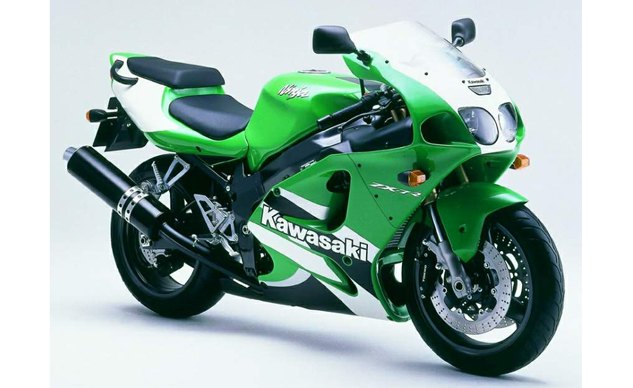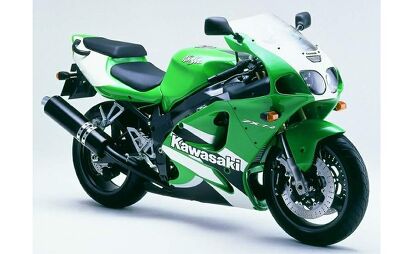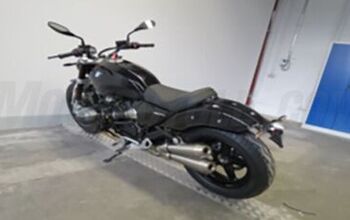Church Of MO – First Impression: 1997 Kawasaki ZX-7R

While Suzuki’s GSX-R750 may be the Godfather of the sportbike category, perhaps the most under appreciated 750 superbike of the time is the Kawasaki ZX-7R. The machine that changed little since 1993 while still managing to win superbike races and titles both here and abroad, many praise it as being one of the best handling sportbikes in existence. In 1997, our own Shawn Higbee (yes, the same Shawn Higbee who was the lead Buell test rider) got his hands on a then-new ZX-7R, for this first ride report. Considering Shawn’s vast experience on two wheels, his ability to evaluate a motorcycle and communicate what it’s doing is top notch. See for yourself in his review below in this week’s Church of MO.
First Impression: 1997 Kawasaki ZX-7R
Steady Refinement is Kawasaki’s Key to Success
By Shawn Higbee, Corbin MO staff Mar. 17, 1997
Photos by Scott Rathburn and Billy Bartels
Kawasaki’s ZX-7R is a perfect example of motorcycle engineering refinement. In 1993 Kawasaki designed the new generation ZX-7R that has, to this day, remained virtually unchanged. For 1997 Kawasaki continued to refine rather than redesign. It’s hard to argue against this approach as it is obviously working on the racetrack. Doug Chandler’s performance on the Muzzy Superbike is proof enough that this machine is extremely competent.
The ZX-7R benefits from having any annoying initial design flaws solved over its four years of steady refinement. This makes for a pleasant ride with little to complain about. Some of the issues Kawasaki addressed over the years were unusable mirrors and providing an ergonomically correct cockpit.
One of the first things you’ll notice when riding the ’97 ZX is that its mirrors are practical, allowing you a broader view than just your shoulders. Its cockpit feels smaller and more compact than on early models, with subtle comfort changes like adjustable levers to suit a wide range of hand sizes that previously were unavailable.
The combination of larger than average trail numbers and peculiarly narrow triple clamps require a heavy push on its handlebars to turn the bike quickly, while the triangulated profile of the Dunlop tires complements the bike’s geometry perfectly, allowing it to reach maximum lean angle quickly and effortlessly.
Other improvements over the original formula include Muzzy’s touches in the form of strengthened crankshaft, two springs per valve and a special baffle in the joint pipe to maximize exhaust pulse effect for more torque. Low and mid torque was improved with a balance pipe connected between the number one and number four header pipes. The head itself was refined with straighter ports, aiming the 38mm carbs at 50 degrees into the combustion chamber.
An experienced rider may now raise the rear to reduce front rake for quicker steering, and its firm ride still will soak up the big bumps. Those interested in commuting may choose to loosen the suspension settings for more comfort around town. I would recommend adjusting the factory settings by reducing front rebound two clicks, and dialing-in one less click of rebound and 3mm less preload on the rear.
The initial bite isn’t there, but a strong hand increases stopping power with its rising rate. Improved from the original 1993-spec machine is the appearance and sound of its exhaust system. The sleek looking pipe has a deep, powerful tone — louder than most stock pipes. Minimal restriction allows the engine to breathe yet it still remains quieter than an aftermarket muffler.
From a distance the 1997 ZX-7R doesn’t look different, but its refinements will be noticed in real world riding. It feels small — like a heavy 600cc bike, but with noticeably more low-end grunt and a little more top end.
The power delivery is one of the most linear I’ve ever sampled, and its spot-on carburetion, instant throttle response and impeccable chassis manners make the ZX-7R a very logical buy.
Specifications:
Manufacturer: KawasakiModel: 1997 ZX-7RPrice: 99.00 Engine: Four-stroke, DOHC, liquid-cooled, 16-valve inline fourBore and Stroke: 73 by 44.7mmDisplacement: 748ccCarburetion: Four Keihin CVKD38Transmission: 6-speedWheelbase: 56.5 inchesSeat Height: 31.1 inchesFuel Capacity: 4.8 galClaimed Dry Weight: 448 lbs

Troy's been riding motorcycles and writing about them since 2006, getting his start at Rider Magazine. From there, he moved to Sport Rider Magazine before finally landing at Motorcycle.com in 2011. A lifelong gearhead who didn't fully immerse himself in motorcycles until his teenage years, Troy's interests have always been in technology, performance, and going fast. Naturally, racing was the perfect avenue to combine all three. Troy has been racing nearly as long as he's been riding and has competed at the AMA national level. He's also won multiple club races throughout the country, culminating in a Utah Sport Bike Association championship in 2011. He has been invited as a guest instructor for the Yamaha Champions Riding School, and when he's not out riding, he's either wrenching on bikes or watching MotoGP.
More by Troy Siahaan











































Comments
Join the conversation
That is one sexy motorcycle.My top three kwakkers:The early 80's GPZ750/1100(nakeds),GPZ1000RX and the one in this article.If I'll buy a kwakker,I think it's gonna be either the 750 or 1100 GPZ.That's because of rumble fish.I shamelessly admit that.